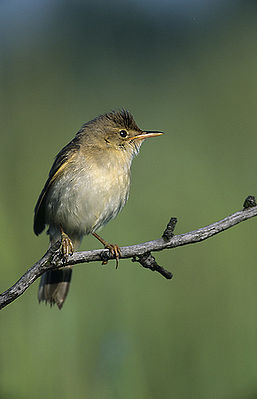Marsh Warbler
| Marsh Warbler | ||||||||||||
|---|---|---|---|---|---|---|---|---|---|---|---|---|

Marsh Warbler ( Acrocephalus palustris ) |
||||||||||||
| Systematics | ||||||||||||
|
||||||||||||
| Scientific name | ||||||||||||
| Acrocephalus palustris | ||||||||||||
| ( Bechstein , 1798) |
The reed warbler ( Acrocephalus palustris ) is a songbird belonging to the genus of the reed warbler ( Acrocephalus ) and the reed warbler family (Acrocephalidae). No subspecies are described.
The reed warbler is a widespread and frequent breeding and summer bird throughout Central Europe.
description

The marsh warbler is about 13 centimeters long and has a wingspan of 17 to 21 centimeters. The weight is about 11 to 14 grams. The upper side is gray-brown, its underside yellowish-white. The little bird has a whitish throat and a pointed beak. Males and females have the same coloration. The reed warbler moves skillfully in dense vegetation and imitates the calls and songs of other bird species, which it mixes with typical reed warbler phrases. It can often be heard in late twilight and at night.
The reed warbler can hardly be distinguished from the reed warbler .
habitat
The Marsh Warbler is a breeding bird of the western Palearctic. Its distribution area extends from the south of Great Britain and Scandinavia through the north and northeast of Finland to northern Kazakhstan. The southern limit of distribution runs from northern Italy and Greece via Bulgaria and the European part of Turkey along the northern coast of the Black Sea . The species occurs even further east to the south and southeast of Anatolia.
In Central and Eastern Europe , the long-distance migrant is present from May to September. His winter quarters are south of the equator in Africa . The reed warbler lives in dense reeds, bushes and grain fields near bodies of water.
nutrition
The reed warbler feeds on spiders , mollusks, insects and their larvae . Aphids and diptera also play a major role in the nestling food .

Reproduction
The main breeding season for the Marsh Warbler is May to July. During this time they build a nest bowl made of grass and reed stalks, which is usually fastened between stalks of nettles or stalks of cereal plants. The female lays three to five bluish-white eggs , which are incubated alternately by both partners for 12 to 14 days. The young birds fledge 10 to 14 days after hatching; after a year they are sexually mature. The European population is estimated at around 1.5 to 2.0 million breeding pairs.
literature
- Hans-Günther Bauer, Einhard Bezzel and Wolfgang Fiedler (eds.): The compendium of birds in Central Europe: Everything about biology, endangerment and protection. Volume 2: Passeriformes - passerine birds. Aula-Verlag Wiebelsheim, Wiesbaden 2005, ISBN 3-89104-648-0 .
Individual evidence
Web links
- Singing marsh reed warbler at www.vogelstimmen-wehr.de
- Acrocephalus palustris in the endangered Red List species the IUCN 2008. Posted by: BirdLife International, 2008. Accessed January 31 of 2009.
- Videos, photos and sound recordings on Acrocephalus palustris in the Internet Bird Collection
- Feathers of the Marsh Warbler
